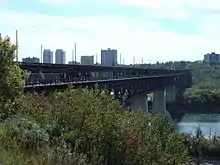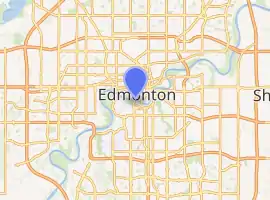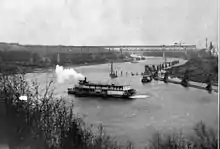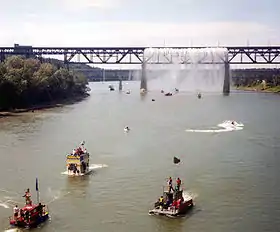High Level Bridge (Edmonton)
The High Level Bridge is a bridge that spans the North Saskatchewan River in Edmonton, Alberta, Canada. Located next to the Alberta Legislature Building, the bridge linked the separate communities of Edmonton and Strathcona, which became one city in 1912. It was designed from the outset to accommodate rail, streetcar, two-way automobile, and pedestrian traffic.[2] The original bridge design included three tracks on the upper deck (one CPR track with one streetcar track on either side).[3][2] The first CPR train (a passenger service) operated on June 2, 1913, after which the bridge became a part of the Calgary-Edmonton main line.[2] Streetcar service started on the west streetcar track of the bridge on August 11, 1913 (at 11 am) with the east streetcar track opening by September of that year and automobile traffic after that.[2] Automobile traffic did not begin at the same time as CPR and streetcar traffic as the lower deck had not been completed and the installation of galvanized iron under the tracks was still needed to prevent cinders dropping from steam trains onto traffic on the lower deck.[2] Streetcars travelling northbound operated on the upstream side of the bridge, and southbound streetcars operated on the downstream side of the bridge; This left-hand operation was contrary to the right-hand driving on the lower traffic deck.[2]
High Level Bridge | |
|---|---|
 Edmonton's High Level Bridge from north bank, above LRT portal, September 2006 | |
| Coordinates | 53°31′50″N 113°30′38.4″W |
| Carries | 109 Street, High Level Bridge Streetcar |
| Crosses | North Saskatchewan River |
| Locale | Edmonton, Alberta, Canada |
| Maintained by | the City of Edmonton |
| Heritage status | Municipal Historic Resource |
| Characteristics | |
| Design | Phillips B. Motley, CPR |
| Material | Steel trusses on concrete piers |
| Total length | 777 m (2,549 ft) |
| Width | 2 vehicular lanes, one-way |
| Longest span | 88 m (289 ft) |
| No. of spans | 28 |
| Piers in water | 4 |
| Clearance below | 48 m (157 ft) |
| History | |
| Constructed by | John B. Gunn and Sons[1] |
| Opened | June 2, 1913[2] |
| Location | |

| |
The bridge was transferred to the ownership of the City of Edmonton in 1994 and designated a Municipal Historic Resource in 1995.[4][5] Trucks are prohibited on the bridge due to the low clearance of 3.2 metres (10 ft 6 in) and substandard lane width. Currently street traffic is one-way southbound. At the north end of the bridge, 109 Street enters into the left lane, and 110 Street enters into the right lane. The next bridge downstream, the Walterdale Bridge, is a three-lane bridge with one-way northbound traffic into downtown.
The last Edmonton Transit System operated streetcar travelled over the bridge on September 1, 1951[2] and the Canadian Pacific Railway (CPR), responsible for the design of the bridge, ceased rail operations over the span in 1989. The upper deck contains only the one middle track now, which is currently used only by the High Level Bridge Streetcar, a historic streetcar route that travels from the Strathcona Streetcar Barn & Museum, just north of the Strathcona Farmers Market, in Old Strathcona, to Jasper Plaza south of Jasper Avenue, between 109 Street and 110 Street, in downtown, with three intermediate stops.

Modifications
On November 19, 1980 two-way traffic on the High Level and Walterdale bridges changed to one-way traffic (northbound for the Walterdale Bridge, and southbound for the High Level Bridge) as a part of "Project Uni", with the intentions of better utilizing the two bridges.[2] As trolley buses formerly traveled in both directions over the Walterdale bridge, this required the addition of electrical wires above the traffic deck on the High Level Bridge to facilitate these buses. Trolley bus service started on the bridge on May 4, 1981, after the addition of the wires.[2] The wires were suspended from a wide corrugated panel that prevented the poles on the buses from getting damaged by the bridge members if they were to become disconnected.[2] After trolley bus service was discontinued in 2009,[6] the electrical wires and panel supporting trolley bus operation on the bridge were removed.
Extensive repairs and the addition and widening of pedestrian sidewalks were completed in 1994–95. The original lead paint on the bridge was carefully removed, and over 100,000 litres of paint were used to recoat the girders.[1]
Completion of new suicide barriers in July 2016 have lowered suicide attempts by 50 percent.[7] However, the barriers, which ended up appearing to be twice the width of the initial approved design and placed on the inside of the existing shared use path railing, reduced the west shared use path width to 2.8 metres (9.2 ft) and the east shared use path to a substandard width of 2.3 metres (7.5 ft).[8][9] A feasibility study commissioned by the city found that it would be "marginally feasible" to widen the existing shared use paths on the bridge, at a cost of approximately $23.7 million, however no changes have been approved.[10]
An engineering study released in February 2018 explained that, even though the bridge was built to support freight trains, it would not be able to structurally support modifications to allow a new LRT line to be built on the top deck, due to corrosion.[4] This led to the city placing a hold on plans for the future Centre LRT Line to cross the North Saskatchewan.[11] By the time the City of Edmonton took ownership of the bridge, the main trusses had lost approximately 44 percent of their width due to rust.[4] Repainting and other maintenance of the bridge slowed the corrosion; It is estimated that during the last 25 years the trusses have lost only an additional 5 percent of their widths.[4] Railway stringers and floor beams on the top deck have lost approximately 42 percent and 50 percent of their original widths, respectively.[4] Even though the bridge cannot support additional load, the bridge was still deemed safe for the current load.[4]
In April 2013, a campaign called "Light the Bridge" was launched, with the aim of covering the bridge with LED lights so it can light up on special occasions.[12] The campaign raised approximately $2.5 million for the project, which was unveiled on July 1, 2014. The official lighting of the bridge was synchronized to the tune of "O Canada", played by the Edmonton Symphony Orchestra and broadcast on CKUA radio.[13] The lights are capable of displaying many different colours and are often programmed to coordinate with local events, such as green and gold for games played by the Edmonton Eskimos.[14]
Great Divide Waterfall

In 1980 the Great Divide Waterfall by artist Peter Lewis was added to the structure for Alberta's 75th anniversary. The man-made waterfall dropped 64 m (210 ft) from the top of the bridge, (7 m higher than Niagara Falls) into the North Saskatchewan River at a rate of 50,000 litres per minute. It operated during holiday weekends in the summer months until 2009 when it was shut off after consultation with Environment Canada.[15]
From roughly April 2012 to April 2013, city council deliberated on whether or not it should re-open the waterfall, and in 2013, $735,000 was allocated for "Great Divide waterfall refurbishment".[16] As of 2014, the city has all but scrapped the plans to refurbish the waterfall, citing the estimated $2.6 million price tag as too high. The final decision to decommission the waterfall was stayed until fall 2014, as public reaction was gauged and community fundraising options were considered.[17] In 2016, city council voted against the removal of the pipes for the waterfall. While there are no current plans to reactivate the falls, the decision to leave the pipes in place allows for that possibility in the future.[18]
The waterfall remains a part of the City of Edmonton's Public Art Collection.[19]
References
- Herzog, Lawrence (February 16, 2006). "Edmonton's "Golden Gate" bridge". Edmonton Real Estate Weekly. Realtors Association of Edmonton. Retrieved November 24, 2012.
- Hatcher, Colin; Schwarzkopf, Tom (1983). Edmonton's electric transit: the story of Edmonton's streetcars and trolley buses. Railfare Enterprises.
- Wong, Julia (30 March 2017). "Wider sidewalks, LRT tracks and shared-use paths on Edmonton's High Level Bridge to be studied". Global News. Retrieved 3 December 2018.
- Stolte, Elise (22 February 2018). "Rust never sleeps: High Level Bridge too weak for LRT, engineers say". Edmonton Journal. Retrieved 3 December 2018.
- "Alberta Register Historic Places – High Level Bridge". HeRMIS. Retrieved 2010-03-03.
- Kent, Gordon (2 May 2009). "Trolleys' last stop on road to oblivion; Supporters mourn decomissioning of fleet". Edmonton Journal. p. B.3.
- "Suicide attempts on High Level Bridge down since barriers installed, city says". Canadian Broadcasting Corporation. 13 June 2017. Retrieved 3 December 2018.
- Lazzarino, Dave (14 July 2016). "High Level Bridge suicide barriers twice as wide as initial design: cyclist". Edmonton Sun. Retrieved 3 December 2018.
- Ohler, Quinn (14 September 2016). "Pathways on High Level Bridge too narrow: Edmonton safety audit". Global News. Retrieved 3 December 2018.
- Jung, Angela (22 February 2018). "LRT would tip High Level Bridge 'over the edge': City". CTV News. Retrieved 3 December 2018.
- Riebe, Natasha (14 August 2018). "City gives up on Centre Line LRT bridge over river, for now". Canadian Broadcasting Corporation. Retrieved 3 December 2018.
- Hoang, Linda (April 29, 2013). "High Level Bridge lights project a 'signature' for world to see, donations start to come in". CTV Edmonton. Bell Media. Retrieved August 7, 2014.
- Wittmeier, Brent (June 30, 2014). "Edmonton's Canada Day spectacular features Light the Bridge debut and fireworks (with video)". Edmonton Journal. Postmedia Network. Archived from the original on August 7, 2014. Retrieved August 7, 2014.
- Mertz, Emily (October 25, 2013). "Light the Bridge campaign crosses halfway mark". Global Edmonton. Shaw Media. Retrieved August 7, 2014.
- "Great Divide Waterfall". City of Edmonton. 2011. Archived from the original on June 16, 2011.
- "Council Roundup – April 10, 2013". City of Edmonton. Retrieved April 22, 2013.
- "Edmonton's Great Divide Waterfall Has Taps Turned Off". Retrieved May 21, 2014.
- "City barred from removing High Level Bridge pipes for pedestrian safety". Retrieved March 25, 2017.
- "Great Divide | City of Edmonton Public Art Collection". Retrieved March 25, 2017.
| Wikimedia Commons has media related to High Level Bridge (Edmonton). |
| Preceded by Dudley B. Menzies Bridge |
Rail bridge across the North Saskatchewan River |
Succeeded by Clover Bar Railway Bridge |
| Bridge across the North Saskatchewan River |
Succeeded by Walterdale Bridge | |
| Preceded by Groat Bridge |
Road bridge across the North Saskatchewan River |